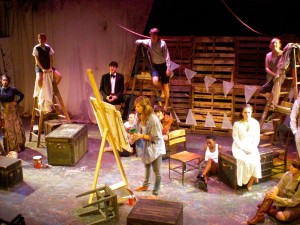Peter Pan stuns with clever design, story
In an artist’s studio somewhere in London, a young woman, Sylvia (Sarah Beth Comfort) throws paint on the canvas. She considers the painting, then takes her brush stroke and adds some green, some red, a little black.

Minimalist magic · Sarah Beth Comfort (center) stars as the narrator in Peter Pan, or The Boy Who Would Not Grow Up. The sparse set allows audiences to use their imaginations to picture the play’s events. – | Photo courtesy of Brianna McDonnell
Finally, she finishes and places it in the corner, perhaps wistfully. Behind Sylvia, the Darling family stands frozen in her apartment. Sylvia begins to describe them in J.M. Barrie’s iconic prose, and they begin to come alive in the studio.
So begins Peter Pan, or the Boy Who Would Not Grow Up, an almost coffee shop-esque adaptation of J.M. Barrie’s classic play, which follows the story of the Peter Pan as he leads the Darling children to Neverland.
As the story begins, the artist’s studio transforms into the Darling nursery. None of the props have changed, but with a little imagination, the stage is different. The chests become beds. The desk, a dog’s cage. Paint cans are bedtime lights. The props give a simple charm to the production that makes it easy to accept the world of the play as Sylvia begins to narrate the Darlings’ day-to-day life.
With three children and a dog, the family’s world is bound to be chaotic. But director Zach Kaufer successfully controlled the chaos, focusing on one person or action when everyone starts to talk at once, such as when the children circle around Mr. Darling to protest his treatment of Nana.
But more than anything, Kaufer’s Pan focuses on the idea of playfulness. As Peter Pan (Philip Labes) comes through the window, looking for his shadow, there is a youthfulness and vigor to him. It doesn’t matter that he is not on a wire and cannot actually “fly.” Rather, Labes’ acting shows he believes he can fly — and because he believes it, it is easy for us to accept that he actually can.
Likewise, it was charming to watch the Lost Boys “build” Wendy’s dream house. She describes a home with windows in every room and roses outside. With a few ropes drawn into a circle serving as the home, the Lost Boys proudly step back and admire their minimal handiwork. Sometimes, props can really be that simple. The production allowed the audience to imagine what the house looks like through Wendy’s descriptions rather than spend the time creating an elaborate set that might not live up to expectations.
The adaptation does not deviate from the original storyline, but through small details, such as the mellow alternative music and the lyrical, interpretive dance transitions that introduce the different fantastical creatures in Neverland, Peter Pan, or the Boy Who Would Not Grow Up nudges the storyline into a new direction, giving the performance a cozy, intimate vibe.
There are other little reminders throughout the play that help to update the original story, with details like the narrator’s Toms shoes or her Skinny Girl Martini bottle, which doubles as a cup that Wendy (Hallie Golov) uses in the imaginary “dinner” she makes for the Lost Boys.
The soft and sad half-duet between Peter and Wendy was one the most successful of the play’s new interpretations. Using the nursery piano as the melody, Golov begins the song and Labes finishes as the two get ready to part ways at the end of the show. Labes, who is a singer-songwriter in real life, added an extra rawness to the concluding verse.
Though all of the actors delivered strong performances, Annelisha Dixon who played the lost boy Tootles “not the least brave,” delivered an exceptional performance. With her wide-eyed, younger-sibling-syndrome prone performance, she stole almost every scene. Austin Welsh, who played the villainous yet fun Captain Hook, also created a great interpretation of the pirate. Welsh, who was assisted by the comical performances of Smee (Ben Greene) and Starkey (Zach Kaufer), played off of their performances with dry humor.
And of course, the always-present narrator gives the plot extra depth. Throughout the performance, she never smiles. She watches, she empathizes, she even assists the players when they need an extra character to serve as Peter’s shadow or as a pirate. She is never actually in the story, though. As an adult, she has grown up and is unable to actually reach Neverland.
Watching the narrator observe Wendy as she goes on adventures is a reminder of how short childhood is. The production questions what happens to fantasy and playfulness when one gets older.
The audience never learns what Sylvia was painting in the beginning of the performance, nor do they learn her past or future. As the curtains close, however, Peter Pan shows up at her window — for what purpose the audience does not know, but one suspects that she has been painting Neverland.
